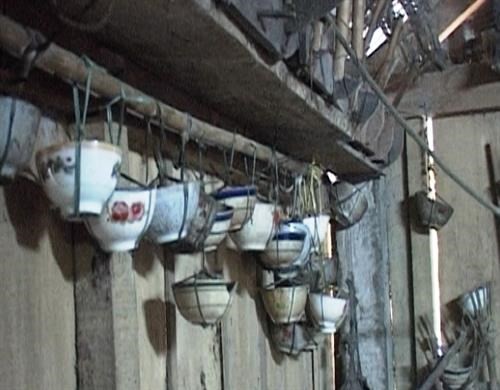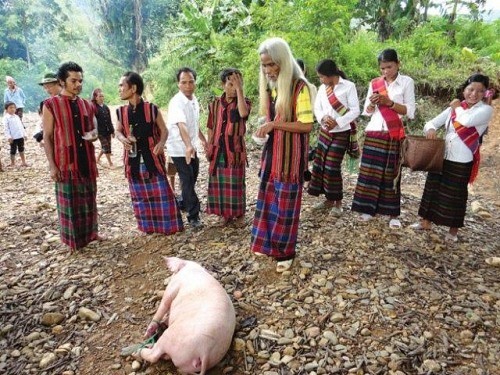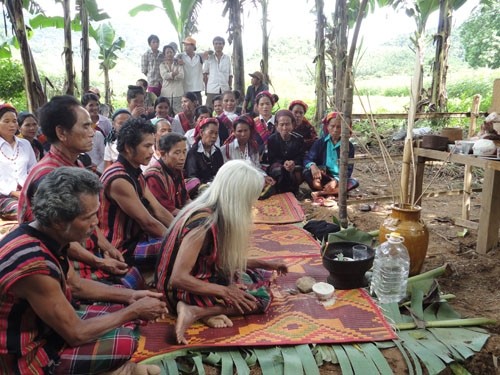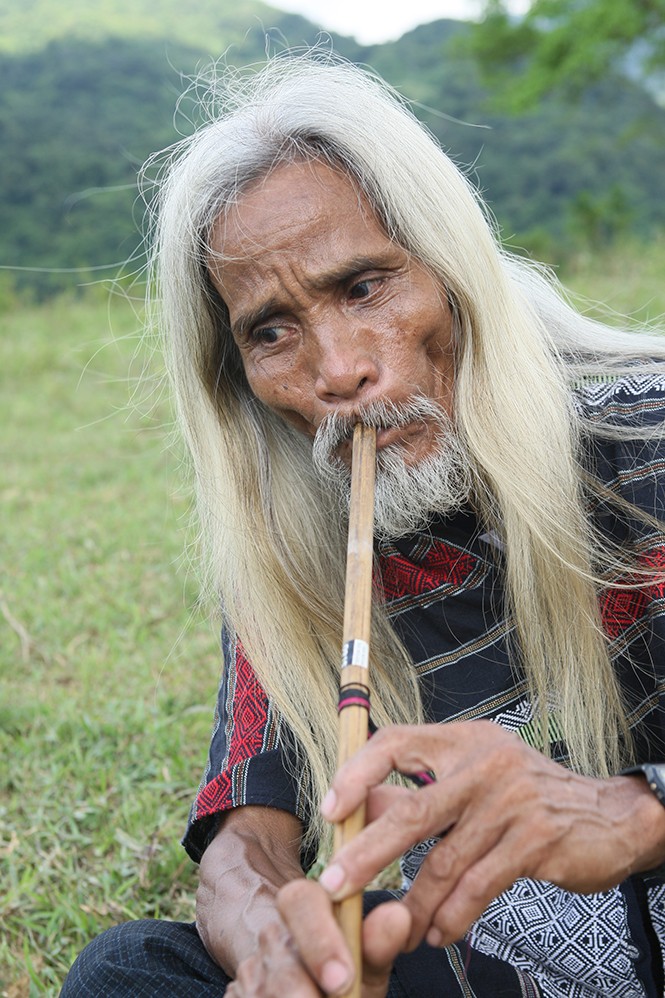Nobody knows when the custom of worshipping the souls of the living began. But the Van Kieu have always believed that each individual has a soul which accompanies them from the day they are born until the day they die. When a newborn is three days old, a soul worship ritual is perform to inform the ancestors of the new family member and ask for their blessing.
“Each person has a soul which takes shelter in a bowl on the family altar. It follows us when we go out and returns to the bowl when we come back home. It must never leave us. When we encounter difficulties, we offer a pig to ask for the soul’s blessing,” said Ho Van Phan of Quang Binh province.
The number of bowls on the altar indicates the number of people in a Van Kieu family. The Van Kieu say worshipping the souls of the living and the souls of the deceased is equally important. They believe that their life is determined by their soul or their “tutelary deity” as they call it. Anything that disturbs the altar of the living calls for offerings to be made to ask for the soul’s forgiveness. Naturally, a Van Kieu altar is always at the highest spot of the house.
 The bowls on the altar of a Bru Van Kieu family. The bowls on the altar of a Bru Van Kieu family. |
“Before the altar can be repaired or replaced, we must prepare various kinds of cakes to ask for the souls’ permission,” said Mr. Phan.
The family of 83-year-old Tran Phuc of Quang Binh are conducting a ritual to pray for his soul to stay a bit longer with him.
“I often get sick because of my advanced age. I won’t live long if my soul leaves me,” said Mr Phuc.
Ho Ai, the hamlet patriarch and one of the best shamans in the area, has been invited to perform the ritual. A woman in the family has brought a bowl of rice with an egg on top of it. The shaman puts two tiger teeth and four leaves wrapped in bee’s wax in the rice bowl, demonstrating his power and the close bond between the Van Kieu and nature. The shaman’s ritual tools included a knife, a bamboo flute called Pi, a bamboo fan, and a turban decorated with sea shells, bear teeth, tiger claws, and insects.
The offerings include rice wine, betel leaves, bee’s wax, two chickens, and a pig. Other items include personal belongings of Mr. Phuc: a handkerchief, a shirt, and a bracelet.
The shaman conducts the ritual to the mesmerizing sound of the bamboo flute which is inviting the soul to stay. The shaman asks the soul to stay with Mr. Phuc as long as possible and ensure him a healthy, happy life.
From time to time, the shaman invites the attendees to drink some wine to show their respect to Mr. Phuc’s soul.
“The shaman stands the knife vertically. If the knife doesn’t fall, it means the soul is still there and vice versa. Members of the immediate family must attend the ritual,” Mr. Ho Aí elaborated.
 A pig is offered to the soul of the living to ask for its blessing. A pig is offered to the soul of the living to ask for its blessing. |
The shaman’s introduction is followed by the most important procedure. Family members put a pig’s head into a bamboo basket tied with a knife. The shaman then stands the knife in the rice bowl. If the knife stands, the soul has agreed to stay, otherwise the soul has refused.
“Everyone is gather here for the ritual. We must stay together to keep the soul from leaving,” Mr. Ho Ai said.
The ritual ends as soon as the knife is able to stand in the rice bowl. People then move to the middle of the house to congratulate Mr. Phuc. Each person ties a red thread blessed by the shamanon on Mr. Phuc’s wrist as a wish for safety and good health, and donate some money to help defray the cost of the ritual.
 The soul worshiping ceremony is conducted by a shaman. The soul worshiping ceremony is conducted by a shaman. |
The most awaited moment is when the shaman distributes the rice in the ritual bowl to the family members. Those who receive an even number of rice grains are believed to have a healthy soul. An odd number means that person’s soul also needs a ritual.
Ho Thi Yeu has received an odd number of rice grains. She drinks some wine and promises to hold a similar ritual when she has enough money.
”An odd number means the soul is unsatisfied. The shaman says I can co-host a ritual with other people who also received an odd number,” Mrs. Yeu said.
To conclude the ceremony, the shaman burns the bee’s wax to thank the soul. He then pours some water on Mr. Phuc’s head and combs his hair to remove sickness and bad luck.
The soul worshipping ceremony is held many times in each Van Kieu’s life, when they are born, are sick, have an accident, or grow old.
Folk songs, dances, and musical instruments are important parts of the cultural life of the Van Kieu. Each form of singing or dancing is designed for a specific occasion. Some musical instruments are used only in worshiping rituals. Others are played at festivals or accompany call-and-response singing sessions.
Patriarch Ho Ai is the leading authority on Van Kieu culture and arts. He is also the best player and maker of traditional musical instrument like the gong, Kho-lui, Sui, Po-lua and Tinh tung musical instrument, and the Pi flute which we mentioned earlier in the show.
 Village elder Ho Ai plays the Pi flute. Village elder Ho Ai plays the Pi flute. |
“The Pi flute, made of bamboo, is played at worshiping rituals, particularly the worshiping of souls. It represents the shaman’s supernatural power. The Pi and Sui flutes, the gongs, and the drums, are sacred items used only at worshiping ceremonies, never festivals,” said Mr. Ho Ai.
The Khui is a noteworthy flute. When being played at festivals, the sound of the Khui expresses the inner feeling of the players.
Customarily, only middle-age men are allowed to play the Khui. Senior villager Ho Van Thuong told us: “In the past men had to watch the rice fields ripen. Sitting idly, they made holes in bamboo sticks to blow for fun. The sound could often be heard in the other fields. They talked to each other by blowing their flutes.”
To make a flute a good tone, you must find a good neohouzeaua, a species of bamboo which is slender and has long sections. The Van Kieu usually choose the day of a full moon to cut the tree. The neohouzeau tree is dried on a shelf in the kitchen for 1 or 2 months. A red-hot iron awl is used to make the holes.
The Van Kieu have other flutes like the Teril young people play to accompany duet singing and the Kholui played at weddings.